One of the most common challenges no-tillers encounter with cover crops is at the very start — getting them seeded.
In the 2014-15 Cover Crop Survey conducted by Sustainable Agriculture Research & Education, cover crop establishment was the No. 1 challenge reported among 2,814 cover crop users, at 21%. Time and labor required for seeding and managing the cover crop came in third at 18%.
Those two challenges were also the top two reasons among nearly 700 survey takers for not using cover crops.
In some areas of the U.S., particularly in northern states, there may not be enough time to get cover crops seeded after harvest — especially if a no-tiller is hoping to achieve decent cover crop growth before winter.
Aerial seeding via an airplane or helicopter is an option, but establishment can be spotty.
Depending on a no-tiller’s goals, climate, row widths, cover crop species and even herbicide programs, interseeding covers — the practice of seeding them with a drill, spinner spreader, toolbar or sprayer into an established and growing cash crop — may provide a solution.
Interseeding Advantages
Predictability is what led Loran Steinlage to interseeding covers on his no-till and strip-till farm in West Union, Iowa.
“Airplanes are too unpredictable,” he says, “and the drill after harvest is too late.”
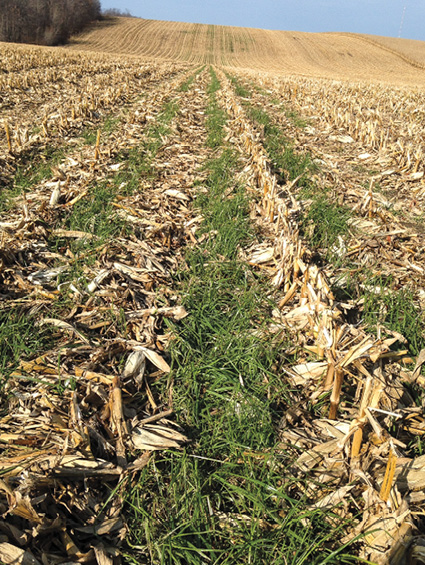
STRONG START. Now in his third year of interseeding, Ontario no-tiller Gerard Grubb has noticed an increase in soil tilth and improved soil structure from the annual ryegrass he’s interseeding into his corn. For his location, interseeding is the only way he can get covers established on time.
So 6 years ago he took a spinner box and seeded his covers by hand, down six cornrows while the corn was still small and growing. Since then he’s gone through six different toolbars he’s modified for interseeding. Now he’s using DawnBiologic’s DuoSeed Cover Crop Inter-Seeder row units on a rig he built to interseed annual ryegrass and clovers into corn at the V4-V6 stage, which he says is the ideal time for his area.
Despite the changes in equipment and associated costs, Steinlage says the cover crops are paying their way. He reports an average 15-bushel increase in the current corn crop and soil organic matter levels average 3-5%, with some field areas climbing up to 6% and 7%.
No-tiller Allen Dean of Bryan, Ohio, had a similar experience to Steinlage. He first tried interseeding cover crops with a helicopter later in the summer, thinking it would do a decent job of distributing the seed. When he found that wasn’t the case, he decided to have an airplane fly on his seed and did that for several years. But he still wasn’t happy with the results.
“In our area there’s a lot of homes, odd-shaped fields and trees,” he says. “And we just knew that if we had a ground rig, we’d do a better job of distributing and getting the seed exactly where we wanted it.”
Today, Dean and his family run a custom interseeding business with the Miller Nitro cab and chassis with a front-mounted boom modified into an inter-row air seeder (see cover photo), and he says the seeding rates and establishment from it are near perfect.
In Indiana, Ag Conservation Solutions no-till consultant Dan Towery is doing interseeding cover-crop trials with several growers at the V4-V7 stage in corn. He says while they haven’t gathered enough research to provide good yield comparisons yet, a group in Quebec has been doing similar research for several years and is reporting a 5-bushel bump in the following soybean crop’s yields, as well as a 4- to 8-bushel increase for corn.
In Decatur, Ind., Mike Werling has a neighbor custom interseed cover crops into corn using drop tubes on a Hagie sprayer and says he’s never had a bad crop. Werling hasn’t calculated a yield increase from interseeding, but that doesn’t mean it’s not paying off.
“My return on investment may just be soil health,” he says. “It doesn’t have to be dollars for me. The value of erosion control is No. 1.”
Mildmay, Ontario, no-tiller Gerard Grubb is in his third year of interseeding cover crops and has noticed an increase in soil tilth and improved soil structure. For his northern location, interseeding is the only way he can get a cover crop established. He tried seeding annual ryegrass after soybean harvest one year, but says it was too late.
Success with Interseeding into Soybeans
Most no-tillers interseeding cover crops are seeding them into corn. But Allen Dean, who only grows soybeans and wheat, has had great success interseeding covers into his soybean crop.
He struggled at first to get the cover-crop stands he wanted in soybeans, but found that by interseeding them in the middle of August — a little earlier than he was before — there’s enough moisture left for the crop to get established. He says soybeans are putting on pods at that time, and a couple weeks later will turn yellow and start dropping leaves.
“I know some guys get a little concerned and ask, ‘How big is this stuff going to be when we get ready to harvest?’” he says. “But we found as we cut the soybeans off the field, the covers hold back a little bit until we get full sunlight.”
He adds that while the covers may be green during harvest, they haven’t impacted harvest operations, noting that they seem to go through the combine with all the dry soybean straw.
Not for Everyone
While interseeding cover crops has its advantages, it may not be the best practice for everyone.
Corn silage is one situation Towery thinks may not work well due to the amount of wheel traffic that usually goes over the field during harvest.
“A lot of them use semis to transport the corn silage,” he says. “You’ve got that little seedling out there and will it tolerate that kind of wheel traffic? You may end up with some, but it may not be what you want.”
Dean adds that corn silage is generally harvested earlier anyway, so growers have a better chance of getting cover crops, especially mixes, seeded afterward.
Another situation that may not work are no-tillers using narrow rows. Towery says without special equipment, he doesn’t think a no-tiller could drive into anything less than 30 inches.
Dean agrees, saying growers with narrow rows will probably be dependent on an airplane if they want to get covers seeded into standing crops.
You May Also Be Interested In...
Finding Your ‘ROI’ with Cover Crops in No-Till Systems
Study farmer-proven ways to implement cover crops into your daily field management. Hear from a cover crop skeptic and his included descriptive data derived from a trial-run period with cover-crop mixes! No matter what side of the fence you land on, download this special cover-crop report and find information-packed farmer testimonials, data and advice suitable for both the experienced and possibly unconvinced farmer. Download now »
Early vs. Late
If a no-tiller wants to interseed his cover crops, one of the first decisions he has to make is when.
Some no-tillers, like Steinlage and Grubb, prefer to do it early in the growing season before their corn crop gets too big, usually between the V4-V7 stage. The key to this method is to use cool-season cover crops that will establish and grow several inches tall while the corn is still small, then go dormant under the corn canopy, Towery says, adding that he considers annual ryegrass the No. 1 cover crop for this.
Interseeding Equipment Options
If you’re interested in purchasing equipment for interseeding, here are a few options currently available on the market.
DuoSeed Cover Crop Inter-Seeder
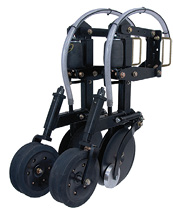
DawnBiologic president Joe Bassett says this inter-row seeding device gives no-tillers a simple, high-clearance, fast way to get their cover crops seeded, with speeds as high as 11 mph possible.
No-tillers mount the row units to a toolbar to create their own drill, he says. Each row unit features an optional row cleaner and double-disc openers with an offset leading disc to cut through residue and seed the cover crop. A rotating, scraping firming wheel next to the openers holds soil down and keeps the blades clean. A seed firmer follows, along with a gauge wheel for depth control and a closing wheel. The opener is mounted on a parallel linkage with airbag down pressure.
DuoSeed units can run on as little as 7½-inch spacings and growers have the ability to mount a different seed tube if they prefer. Bassett says the row unit is suitable for interseeding, drilling cash crops like soybeans, applying fertilizer and as a light strip freshener for strip-tillers.
FE4R System
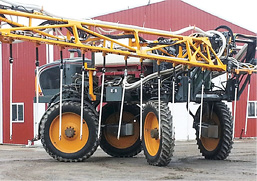
Currently designed for the Hagie STS series sprayers, the FE4R system from Fennig Equipment is capable of seeding cover crops and dry fertilizer on 90- or 120-foot boom widths using a stainless steel meter and section control. Owner Gary Fennig says they are working on developing the system to fit different brands and sprayer models.
Interseeder
Developed by Penn State and manufactured by Interseeder Technologies, the Interseeder drill is designed to interseed cover crops, sidedress liquid nitrogen and apply herbicide at the same time. There are three drill units between each row, spaced 7½ inches apart.
Other features include assist wheels to carry weight, a ground drive to meter seed, a loading platform for loading seed and a hitch for towing. Additional row units can be added to convert it to a full no-till drill.
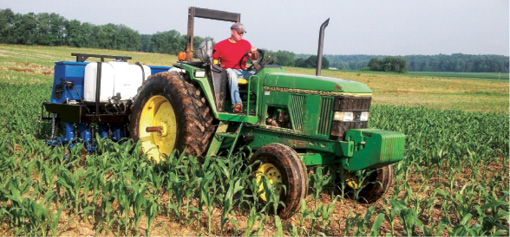
A common concern about seeding a cover crop that early is it could steal water or nutrients away from the growing corn crop. But Towery says if it’s seeded at the right time, it shouldn’t be a problem.
“The whole point of putting it in corn when it’s V4 is getting enough sunlight to get the cover crop established, but then the corn shades it and it’s what I call semi-dormant,” he explains. “It’s just sitting there. It’s not using a lot of water. Not using much nitrogen.”
Towery has measured the roots of annual ryegrass seeded at that time and found they only grew to 4-5 inches before corn harvest. Competition shouldn’t be a problem unless no-tillers seed covers at V2 or earlier.
“We’ve been inundated over the years with the message that you can’t have anything competing with the crop,” he says. “If it’s weeds that can grow taller than corn, yes, that’s bad. But in this case, with cover crops, it’s very compatible.”
On the other hand, if a no-tiller seeds covers too late and it doesn’t get them established before the canopy closes, he probably won’t have a cover crop stand after harvest.
But if a no-tiller wants to use a cover crop that may not survive that type of shading, such as cereal rye, then interseeding later in the season may be the better option.
That’s the case for Werling, who prefers using cereal rye. He says it’s a great cover for planting his soybeans into and creates a lot of biomass to suppress weeds. He also interseeds rapeseed with the cereal rye because it’s an inexpensive species that germinates quickly.
Werling prefers to seed covers at corn’s black layer because that’s when the corn starts to drop its leaves, which provides sunlight to the covers.
Gary Fennig, whose company developed the FE4R system for fertilizer application and cover-crop seeding on the Hagie highboy sprayers, says Fennig Equipment has tried seeding cover crops both around sidedress time and toward the end of the growing season, and both methods get the job done.
“That’s the whole background of the interseeding process — getting the cover crop established before harvest so you have something there over the winter,” he says.
Moisture is Key
Whether a no-tiller is interseeding covers at sidedressing time or when the cash crops are reaching maturity, weather conditions are still an important factor to consider.
While Werling has never lost a cover crop from interseeding, if the weather is dry, the cover crop stand may be thinner or emerge slower than usual, he says.
Weather may have a greater impact on the no-tillers interseeding earlier. Towery says no-tillers might lose a cool-season cover crop if it’s seeded in dry soils and it doesn’t rain for 2 weeks. He adds that a prolonged hot and dry period in August to early September may results in the loss of a cover crop stand, since the cover crop roots aren’t very deep.
This is why Grubb tries to interseed right before a rain.
“As soon as I finish sidedressing my corn, I want to get in there at about the sixth leaf stage,” he says. “And I will do my best to get it on before a rain. It’s going to go on — the sooner the better at the sixth leaf stage.”
Grubb notes that the more rain he receives, the more even the cover crop stand is throughout the field.
Towery adds that interseeding at the V4-V7 stage may not be suitable for the southern Corn Belt. He speculates that south of Indianapolis typically may be too warm and dry for this practice with cool-season cover crops. Also, sandy soil types may not be a good fit for interseeding, unless they are irrigated.
Start with Herbicides
While there’s a decent track record of success with no-tillers making interseeding work, one major potential stumbling block is residual herbicide, if seeding between V4 and V7, vs. seeding cover crops approximately 6 weeks later.
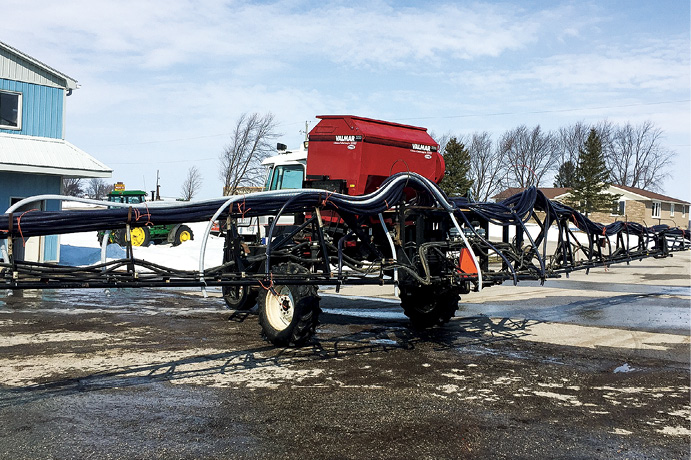
EVEN ESTABLISHMENT. Ontario no-tiller Gerard Grubb is using an AGCO Spra-Coupe 4455 sprayer with a Valmar 3255 air seeder to interseed his cover crops. Originally he was using a Flexi-Coil air cart, but he didn’t have any control on the seeding rate. He says the Valmar seeder lets him seed more rows accurately and evenly.
Unfortunately there’s no clear-cut solution for avoiding herbicide carryover, as soil characteristics and weather both play a role in herbicide degradation.
“When you apply an herbicide to the soil, the No. 1 factor that determines how much is going to be there later is how strongly it’s absorbed by the soil,” says Bryan Young. “If it’s absorbed by the soil it can’t degrade. That’s why Roundup sticks to your soil for up to 3 weeks for a half-life, because it’s tightly bound to the clay minerals. It eventually gets released, and when it does, it degrades.”
The Purdue University weed scientist adds that weather also impacts herbicide degradation, because microbes need certain conditions in order to break it down.
“It needs the right water and air temperature. It’s kind of like if they put you on Mars, what would you need to live? That’s what your microbes need too,” Young explains. “If you have those conditions, you’re going to favor the breakdown of the herbicide. If you don’t have those conditions — you have drought, you have cold conditions, you don’t have the right pH — well, you’re not going to have faster breakdown.”
No-tillers and weed scientists have found some herbicides shouldn’t be a problem, while others should be avoided.
Towery says Verdict and Sharpen both provide burndown capabilities and have a short residual effect. He encourages no-tillers to use them as a pre-plant application and then come back with glyphosate or Liberty, depending on the herbicide-tolerant corn trait, right before seeding.
As for herbicides to avoid, Towery says Lumax and Callisto can’t be used with legumes, while Dual and Zidua should be avoided on grasses. He adds that atrazine can work if it’s applied at less than 1 pound per acre.
Steinlage originally moved away from residual herbicides because of the carryover issues he witnessed in his cover crops. While he wasn’t having weed issues, he says he could see them coming.
So to bring residual herbicides back into his weed-control program he built brackets for his planter so he could band herbicides in the corn row and still interseed covers.
“I went back to a simple, cheap acetochlor product with some atrazine in a 10-inch-row band,” he explains. “Our weed issues haven’t been in between the rows, they’re right on the row where you cleared the strip. We usually have enough residue piled in between the rows that weeds are a non-issue.”
Selecting Species
While annual ryegrass is the most common cover crop species used for interseeding at V4-V7, there are a few others that can work during that time frame and later in the growing season.
Steinlage has had good success interseeding annual ryegrass with clovers, as his goal is to reduce erosion and produce nitrogen (N). He’s also experimenting with radish, rape, phacelia, hairy vetch and several other species. He says his highest mix this year was seeded at 10 pounds per acre. His maximum seeding rate for annual ryegrass is 8 pounds per acre and clover is 6.
Last year, Grubb interseeded 12-16 pounds per acre of annual ryegrass, but this year he used 10 pounds with 2 pounds of crimson clover. He’s trying to add more biology to the soil.
“I want something simple that would work favorably for retaining nutrients in the soil,” he says. “But we have to remember that corn is the reason we’re in the field. We can be all gung-ho about cover crops, but have to be focused on whatever we do out there, we don’t want to take away from the yield in the field.”
Fennig recommends no-tillers start out interseeding something easy that they’re already familiar with.
“Oats and radish are a good combination because you don’t have to worry about terminating them in the spring,” he says. “Just make sure you know how many pounds you’re putting down and how you’re going to control it here come next March and April.”
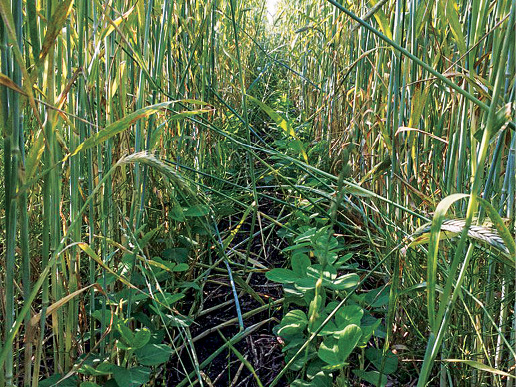
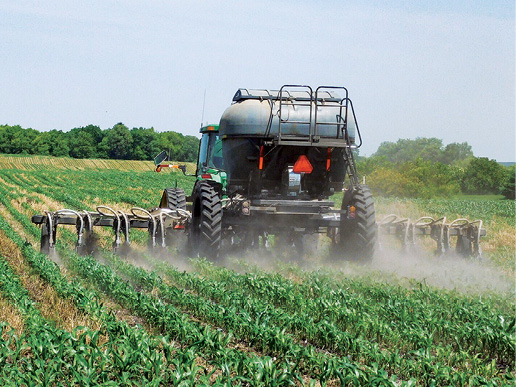
SEARCHING FOR PERFECTION. Now on his seventh piece of equipment for interseeding, Iowa no-tiller and strip-tiller Loran Steinlage says his DawnBiologic DuoSeed Cover Crop Inter-Seeder (right) is working “phenomenally,” noting he used it this year to drill soybeans (left) and urea, sidedress nitrogen and then interseed covers. He typically sees a 15-bushel increase in that year’s corn yields where he interseeded annual ryegrass with clovers into them at the V4-V7 stage. The yield increase alone is making the cover crops pay for themselves, Steinlage says.
Werling has tried species other than cereal rye and rapeseed for interseeding, but says none of them have worked as well, explaining that the radishes die when they’re run over during harvest. His general seeding rate is 50 pounds of cereal rye and a half pound of rapeseed.
Dean, who likes to interseed into mature corn and soybeans — around the middle of August for his northwest Ohio area — mostly uses annual ryegrass and cereal rye, which he seeds at 12-15 pounds and 56 pounds per acre, respectively. He’s also seeing success with blends that include crimson clover and canola.
Equipment Matters
Once no-tillers decide on interseeding timing, herbicides and cover crop species, choosing equipment for application is the next big decision.
If the option is available, hiring someone with an interseeder to custom seed cover crops may be an option. Werling says his custom applicator uses a Hagie sprayer with a Valmar air seeder and drop-down tubes to seed the covers in between the corn rows, and notes the stand is much better than when the Hagie was running a Gandy air seeder.
“Now he can do better rates,” he says. “Before he was limited with the Gandy. He would drive so slow and if it had any chaff in it, he would have trouble. The Valmar will seed anything.”
Grubb is also using a Valmar 3255 air seeder, which he mounts to his AGCO Spra-Coupe 4455 sprayer. He says he’s modified the unit so he can take the tank off and mount the Valmar on in a few hours.
Originally he was using a Flexi-Coil air cart on the back of his sprayer to experiment with interseeding, but he didn’t have any control on the seeding rate, prompting him to invest in the Valmar seeder.
“The other thing is I was driving a big tractor and air cart through the field and we have to be primarily concerned with the crop in the field,” Grubb says. “If you hit cornstalks and run some plants over, it’s going to hurt your yield.
“With the Valmar unit on my three-wheel sprayer, I’m seeding a lot more rows more accurately and more evenly.”
Dean and his family modified the Miller sprayer so it could variable-rate seed their cover crops, allowing them to bump up their seeding rate on slopes and areas more susceptible to erosion.
The seeder also has a scale, Dean says, which allows them to double check that the Miller Nitro is seeding the cover crops at an accurate rate.
Steinlage has been modifying and experimenting with different seeding equipment every year since he started interseeding, including a Hiniker drill that he adapted for twin-rows and using drop tubes on his toolbar.
This year Steinlage modified DawnBiologic’s DuoSeed Cover Crop Inter-Seeder on a Dalton toolbar that he ran with a Hiniker box to drill soybeans, then switched the Hiniker for a Montag to interseed covers and sidedress nitrogen.
“It’s working phenomenal,” he says. “We drilled soybeans and urea with it, and did all of our sidedressing with it. We then switched right over to interseeding cover crops.”
Steinlage is planning on running the DuoSeed Cover Crop Inter-Seeder again next year but hopes to add a Montag Gen II nutrient metering system on the machine next year so he can seed cover crops and apply urea at the same time.
“I’m trying to eliminate passes, but I’m also trying to get the most out of one piece of equipment,” he says.
Fennig says the FE4R system was designed to do just that — allow growers to utilize their sprayer for more than just spraying. Adding the system to the Hagie high-clearance sprayers allows no-tillers to interseed their cover crops and make dry fertilizer applications.
Fennig says the FE4R system is currently designed just for the Hagie sprayers, but they’re working on having it fit different models.
“There are a lot of companies trying to come up with the best way to do interseeding,” he says. “This is just one way a farmer can utilize what he has already.”

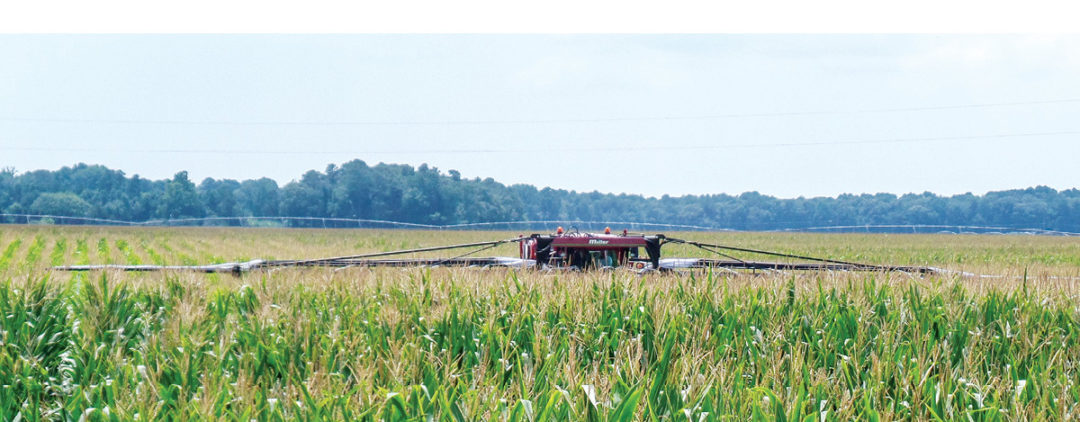






Post a comment
Report Abusive Comment